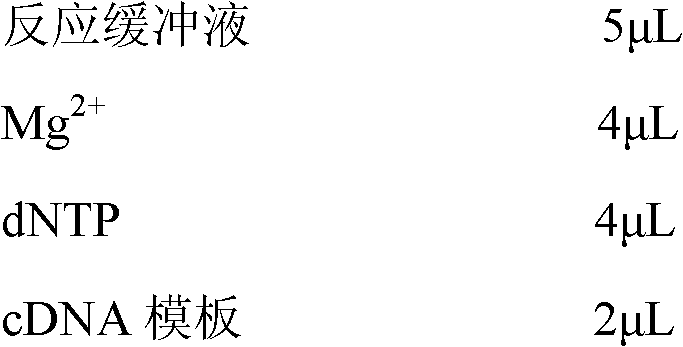Gene silencing technique based Laodelphax striatellus lethal gene fragment Tubulin and dsRNA thereof
A gene fragment and technology of SBPH, applied in the field of agricultural biology, can solve problems such as environmental pollution and poor control effect of chemicals, and achieve the effects of convenient experimental operation, reduced mechanical damage, and low synthesis cost
- Summary
- Abstract
- Description
- Claims
- Application Information
AI Technical Summary
Problems solved by technology
Method used
Image
Examples
Embodiment 1
[0038] 1. Cloning method of Tubulin gene fragment:
[0039] (1) Get 10-20 heads of SBPH, and use the TRIzol method to extract total RNA;
[0040] (2) Synthesizing the first strand of cDNA;
[0041] (3) Obtain the gene fragment sequence from the SBPH transcriptome, and after homology comparison at http: / / www.ncbi.nlm.nih.gov / , it is predicted to be the SBPH Tubulin gene, using Primer premier 5.0 Software design P 1 and P 2, amplified by RT-PCR method;
[0042] Upstream primer (P1): 5'GCGACTTGTGAACCTG 3' (SEQ ID NO.2),
[0043] Downstream primer (P2): 5'TCTGCTGACGCTGAAA 3' (SEQ ID NO.3);
[0044] The PCR reaction program was: denaturation at 94°C for 2 min, 30 sec at 94°C, 30 sec at 55°C, 30 sec at 72°C, 35 cycles, and extension at 72°C.
[0045] PCR reaction system (50μL):
[0046]
[0047]
[0048] (4) The PCR product is separated by agarose gel electrophoresis, and the target DNA fragment is recovered;
[0049] (5) Insert the recovered target fragment into the pEA...
Embodiment 2
[0053] Embodiment 2.dsRNA synthesis and recovery
[0054] (1) According to the verified Tubulin gene fragment sequence, use Primer Premier 5.0 software to design P3 and P4.
[0055] The T7 promoter sequence TAATACGACTCACTATAGGG was added to the 5' end of the downstream primer;
[0056] Upstream primer (P4): 5' TAATACGACTCACTATAGGGGCGACTTGTGAACCTG 3' (SEQ ID NO.5)
[0057] Upstream primer (P5): 5' TAATACGACTCACTATAGGGTCTGCTGACGCTGAAA 3' (SEQ ID NO.6)
[0058]
[0059] PCR reaction program: denaturation at 94°C for 2min, 30sec at 94°C, 30sec at 60°C, 30sec at 72°C, 38 cycles, extension at 72°C.
[0060] (2) The PCR product was separated by electrophoresis on a low-melting point agarose gel with a concentration of 1% and observed under ultraviolet light. The results are shown in figure 1 , whose sequence is shown in SEQ ID NO.4.
[0061] (3) Using Promega's SV Gel and PCR Clean-Up System kit for recovery:
[0062] ① Cut the gel of the separated target fragment, put it i...
Embodiment 3
[0072] Embodiment 3.dsRNA feeding experiment
[0073] (1) Seal one end of the glass tube with a parafilm, suck the second-instar SBPH into the glass tube with a sucker, and seal the other end with gauze;
[0074] (2) Gently pat the insects to one end with your hands, remove the gauze from the other end, and put the prepared parafilm sticker face up, pull evenly to both sides, pull it into a square, and then cover it on the glass On the nozzle of the tube, place the tube upright on the ultra-clean table;
[0075] (3) Draw 100 μl of feed with a pipette gun and drop it in the center of the sealing film, the control only adds feed (see Table 2 for formula), the treatment group adds dsRNA of Tubulin gene (see Table 1 for concentration) in feed, and seals with a new Film, with the side of the sticker facing down, is pasted on the nozzle of the glass tube, and the feed and dsRNA are sealed between two layers of parafilm;
[0076] (4) Put the glass tube with feed and dsRNA back on t...
PUM
 Login to View More
Login to View More Abstract
Description
Claims
Application Information
 Login to View More
Login to View More - Generate Ideas
- Intellectual Property
- Life Sciences
- Materials
- Tech Scout
- Unparalleled Data Quality
- Higher Quality Content
- 60% Fewer Hallucinations
Browse by: Latest US Patents, China's latest patents, Technical Efficacy Thesaurus, Application Domain, Technology Topic, Popular Technical Reports.
© 2025 PatSnap. All rights reserved.Legal|Privacy policy|Modern Slavery Act Transparency Statement|Sitemap|About US| Contact US: help@patsnap.com



